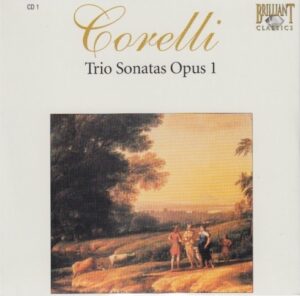 And so begins my exploration of a new composer: Arcangelo Corelli (1653-1713), who was – as I’ve learned from reading his bio on Wikipedia – a big deal back in the day.
And so begins my exploration of a new composer: Arcangelo Corelli (1653-1713), who was – as I’ve learned from reading his bio on Wikipedia – a big deal back in the day.
Arcangelo Corelli (17 February 1653 – 8 January 1713) was an Italian composer and violinist of the Baroque era. His music was key in the development of the modern genres of sonata and concerto, in establishing the preeminence of the violin, and as the first coalescing of modern tonality and functional harmony
He was trained in Bologna and Rome and spent most of his career there with the protection of wealthy patrons. Though his entire production is limited to just six published collections – five of which are trio sonatas or solo and one of concerti grossi — he achieved great fame and success throughout Europe, in the process crystallizing widely influential musical models.
His writing was admired for its balance, refinement, sumptuous and original harmonies, for the richness of the textures, for the majestic effect of the theatricality and for its clear, expressive and melodious polyphony, a perfect quality of classical ideals, although belonging to the baroque epoch and often employing resources typical of this school, such as the exploration of dynamic and expressive contrasts, but always tempered by a great sense of moderation.
Although that last paragraph reads as though only a true fan boy could have written it, I am intrigued to discover what Corelli created and how it has been performed and recorded for this 10-CD box set from Brilliant Classics, one of the best record labels in the world for affordable-yet-high-quality Classical music.
 A cursory glance at the back of the CD sleeve alerts me to the fact that there are 48 tracks on CD 1. Forty eight!
A cursory glance at the back of the CD sleeve alerts me to the fact that there are 48 tracks on CD 1. Forty eight!
The reminds me of a joke from the late comedian Mitch Hedberg:
“Rice is great if you’re really hungry and you want to eat two thousand of something.”
In this case, I get 48 of something – Arcangelo Corelli.
So, as I sip my cinnamon-laced Light Roast coffee at Panera, I’ll listen to Corelli, work on my screenplay, and think thoughts from long ago and far, far away.
Just the Facts
CD 1 of this 10-CD box set consists of 48 tracks that clock in at 68:45.
According to the information on the back of the box, the music was performed by Musica Amphion, conducted by Pieter-Jan Belder, lead by Remy Baudet.
I hadn’t heard of Musica Amphion before now. According to the booklet in the box set,
Musica Amphion, founded by harpsichordist/recorder play Pieter-Jan Belder, focuses on performing 17th and 18th century orchestral and chamber music on original instruments.
Indeed, unless I am mistaken, most of the instruments listed on the CD sleeve for each musician appear to be old, old, old.
Remy Baudet, violin (G. Grancino 1695)
Sayuri Yamagata, violin (J. Stainer 1669)
Albert Bruggen, cello (Italian, circa 1700)
Mike Fentross, theorbo (A. Holst, 1981, after Tieffenbrucker)
Pieter-Jan Belder, organ
My first thought was, “Seriously? You’re playing a violin that’s over three centuries old?”
I Googled the name “G. Grancio” and discovered that a 1695 violin from Giovanni Battista Grancino was listed by Sotheby’s. No price given. (As the old saying goes, “If you have to ask, you can’t afford it.”)
I also Googled “theorbo” and discovered on its Wiki page that it’s a “plucked string instrument of the lute family.”
The performances were recorded in 2004.
According to the CD sleeve, “Sonate da Chisea a tre, opus 1 (Rome, 1681), dedicated to Christina of Sweden.”
So, I Googled “Corelli opus 1 dedication to Christina of Sweden” and discovered a web site with an article that told me Christina wasn’t just some babe Corelli took a fancy to. She was the Queen of Sweden at the time. See for yourself here.
See what I learn doing these projects?
The recording is marked DDD, which means it is an all-digital recording. (Digitally recorded, Digitally mixed, and Digitally mastered.) Purists, those folks who think vinyl sounds better than CDs (they’re wrong) would probably look askance at this recording. To my ears, this is the best way to record music to precisely capture every note. But what do I know?
Just the Feelings
Recording quality: 5
Overall musicianship/vocals: 5
CD liner notes: 2
How does this make me feel: 4
This recording is typical of Brilliant Classics. It’s bright, well produced, lively, and smile-inducing. By the last, I mean that I am always treated to something special when I listen to a recording from Brilliant Classics. I learn a lot – about musicians, instruments, composers, or the periods in which the composers, well, composed) – and I’m pleased that my purchase was so affordable. I don’t know how Brilliant Classics does it.
The only downside to this Corelli box set is that its liner notes – a glossy 12-page booklet – aren’t as complete as the notes in the Tallis box, which was in pdf form on a CD-ROM.
I would have liked to have learned more about these compositions, when, where, and why they were composed.
Since I have 10 days to spend with Corelli, I’ll probably explore his extensive Wikipedia entry more fully in the days ahead.
For now, under overcast skies, a heavy drizzle (big droplets), and a temperature of just 50 degrees (still, probably higher than a typical March in Michigan), I’ll draw my first exposer to Arcangelo Corelli to a close and get on with my other projects.
